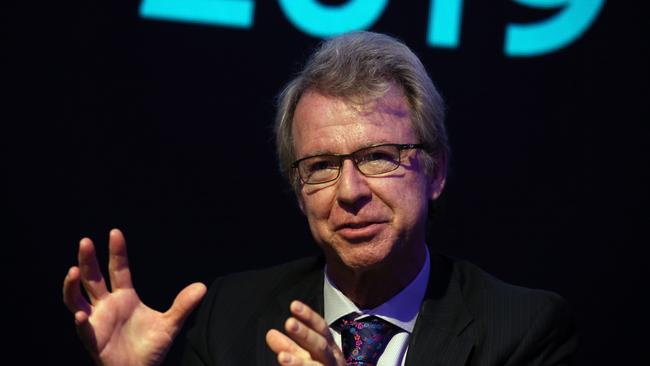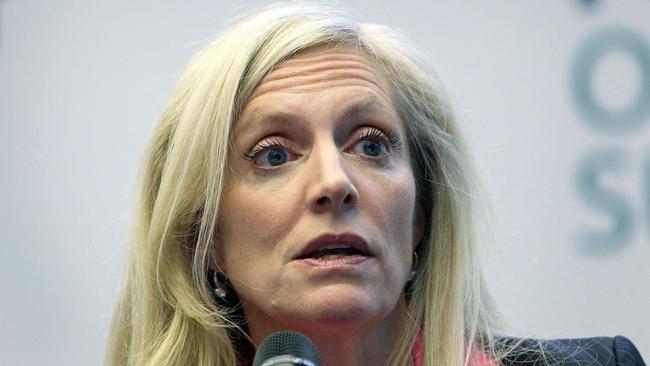‘Array of macro risks’ raises doubts over bounce
Global economic dark clouds gathering suggest forecasts of clear air is unlikely, particularly as the latest US intraday bounces have a precedent – they happened early during the GFC too.
Higher-than-expected US inflation data increased the risk of US recession caused by aggressive interest rate rises, but shares found support from seasonal and technical factors.
In a wild ride after the release of US CPI data for September, the S&P 500 dived 2.4 per cent to a two-year low of 3491.6 points before ending up 2.6 per cent at a five-day high of 3669.9 points.
With the aggressive rebound in the US market, Australia’s ASX 200 rose 1.8 per cent. The dollar bounced to US63.44c after hitting a 2½-year low of $US61.7c.
At the end of what has often been a bad time of year for shares and the start of what is normally a strong few months, the S&P 500 also bounced off a widely watched chart point – 50 per cent of its rise from the low in 2020 to the high in 2022 – at 3505 points.
A 5 per cent intraday rebound in the S&P 500 was its biggest since the start of unprecedented monetary and fiscal policy stimulus in the early stages of the pandemic.
It was the fifth-biggest intraday bounce in the US benchmark from a new 12-month low since 1962. Three equivalent bounces occurred in the early stages of the Global Financial Crisis.

But it took six to 15 months for the S&P 500 to bottom – some 45-50 per cent lower, and it was 2½ to three years before the S&P 500 regained the levels seen after those rebounds in 2008.
There’s little talk of a global crisis at this time, but recession risks are growing.
With US core CPI hitting a 40-year high of 6.6 per cent versus the Fed’s target of 2 per cent, market expectations for the peak of the Fed funds rate shifted up to 4.92 per cent.
The US two-year bond yield rose 17 basis points to a 15-year high of 4.46 per cent and the two to 10-year bond spread hit a 40-year low of 52 basis points, indicating a US recession is likely.
Meanwhile, the UK and Europe face deep recessions linked to the energy crisis as well as interest rate rises to control inflation. It also remains to be seen if UK gilts can stand on their own feet after emergency Bank of England support ends this week, and as the BoE goes ahead with plans to start quantitative tightening at the end of the month, when the UK budget is also due.

UK Chancellor of the Exchequer Kwasi Kwarteng’s early return from IMF meetings has fuelled speculation that the Truss government is poised to further curb fiscal expansion plans, which sparked the rout in gilts.
That speculation led to a massive 73-basis-point fall in the UK 30-year yield before the weekend.
AMP Capital’s head of investment strategy and chief economist, Shane Oliver, noted the period ahead tended to be stronger for US shares, particularly after the midterm elections. “US shares have consistently rallied after US midterm election years, with year three being a strong year on average in the four-year election cycle after year two (this year), which is normally a poor year,” he said. “Sharemarket seasonality also starts to turn more positive in the months ahead.”
But near-term downside risks remain for shares amid an “array of macro risks”.
Central banks were “ultra-hawkish”, recession risks were “high and still rising”, the US dollar’s rise on global safe haven demand was “risking a financial accident”, UK fiscal policy “mayhem” was ongoing, the Ukraine war has escalated and corporate earnings forecasts faced downgrades.
“Despite lots of bounces, the latest of which looks technically driven by program trades and profit taking on put option positions, sharemarkets remain stuck around their June lows – a decisive break of which could open up another 5-7 per cent leg down,” Dr Oliver said.

On a positive note, the Federal Reserve’s September board meeting this week showed that most thought the risk of lifting rates too much was outweighed by the risk of not increasing rates enough, as a dovish group appeared to be emerging within the Fed.
“Several participants noted that, particularly in the current highly uncertain global economic and financial environment, it would be important to calibrate the pace of further policy tightening with the aim of mitigating the risk of significant adverse effects on the economic outlook,” the minutes said.
Dr Oliver said the doves “appear to be led by vice-chair Lael Brainard, who reiterated the need to allow for policy lags, the impact of the rising US dollar and the combined impact of policy tightening globally. But thanks to the poor September CPI report, this group is most unlikely to get the upper hand by November’s meeting, but it may slow things down thereafter.”
“These considerations may not stop further near-term downside in shares, but hold out the likelihood that global central banks (led by the Fed) will start to slow the pace of rate hikes from later this year. That should help minimise any recession and then see sharemarkets refocus on recovery.”







